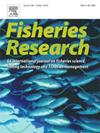Dwindling deep-water fish stocks in the Azores: The first quantitative assessment
IF 2.3
2区 农林科学
Q2 FISHERIES
引用次数: 0
Abstract
Anthropogenic impacts on marine ecosystems are increasing, especially in the deep-sea. Deep-water fishing effort has increased rapidly in the last four decades. However, the economics and sustainability of deep-water fisheries remain debated. This study applied the Stochastic Surplus Production Model in Continuous Time (SPiCT) model to provide the first quantitative assessment of four data-limited deep-water/demersal fish stocks using the Azores as a case study. The application of SPiCT followed good practice and benchmark assessment guidelines and converged for all four assessed stocks. The results showed that blackspot seabream, blackbelly rosefish, and red porgy are classified as overfished, while forkbeard is classified as a recovering stock. These findings underscore the vulnerability of these deep-water stocks to overfishing and advocate for reductions in current catches based on the recommended harvest control rules. Additionally, the study demonstrates that the SPiCT model serves as a valuable tool for stock assessment in data-limited deep-water/demersal fisheries and can enhance their category to data-moderated stocks.
亚速尔群岛不断减少的深水鱼类资源:第一次定量评估
人类活动对海洋生态系统的影响与日俱增,尤其是在深海。在过去的四十年里,深海捕鱼量迅速增加。然而,深海渔业的经济性和可持续性仍存在争议。本研究应用连续时间随机盈余生产模型(SPiCT),以亚速尔群岛为例,首次对四个数据有限的深水/底层鱼类种群进行了定量评估。SPiCT 的应用遵循了良好做法和基准评估准则,并对所有四个评估种群进行了收敛。结果显示,黑点鲷、黑腹玫瑰鱼和红鲷被归类为过度捕捞,而叉须被归类为正在恢复的种群。这些发现强调了这些深水种群易被过度捕捞的脆弱性,并主张根据建议的捕捞控制规则减少目前的渔获量。此外,该研究还表明,SPiCT 模型是对数据有限的深水/底层渔业进行种群评估的重要工具,并可加强其对数据调控种群的分类。
本文章由计算机程序翻译,如有差异,请以英文原文为准。
求助全文
约1分钟内获得全文
求助全文
来源期刊

Fisheries Research
农林科学-渔业
CiteScore
4.50
自引率
16.70%
发文量
294
审稿时长
15 weeks
期刊介绍:
This journal provides an international forum for the publication of papers in the areas of fisheries science, fishing technology, fisheries management and relevant socio-economics. The scope covers fisheries in salt, brackish and freshwater systems, and all aspects of associated ecology, environmental aspects of fisheries, and economics. Both theoretical and practical papers are acceptable, including laboratory and field experimental studies relevant to fisheries. Papers on the conservation of exploitable living resources are welcome. Review and Viewpoint articles are also published. As the specified areas inevitably impinge on and interrelate with each other, the approach of the journal is multidisciplinary, and authors are encouraged to emphasise the relevance of their own work to that of other disciplines. The journal is intended for fisheries scientists, biological oceanographers, gear technologists, economists, managers, administrators, policy makers and legislators.
 求助内容:
求助内容: 应助结果提醒方式:
应助结果提醒方式:


